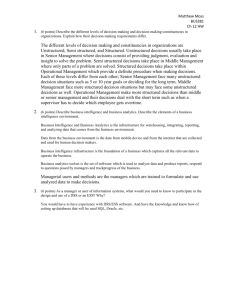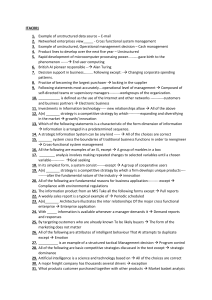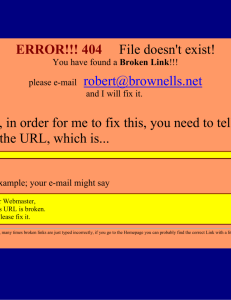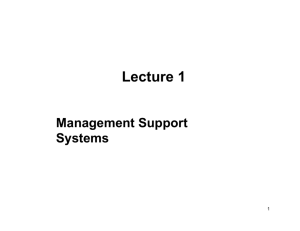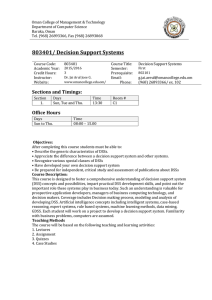Intro To IT Decision Support Systems
advertisement
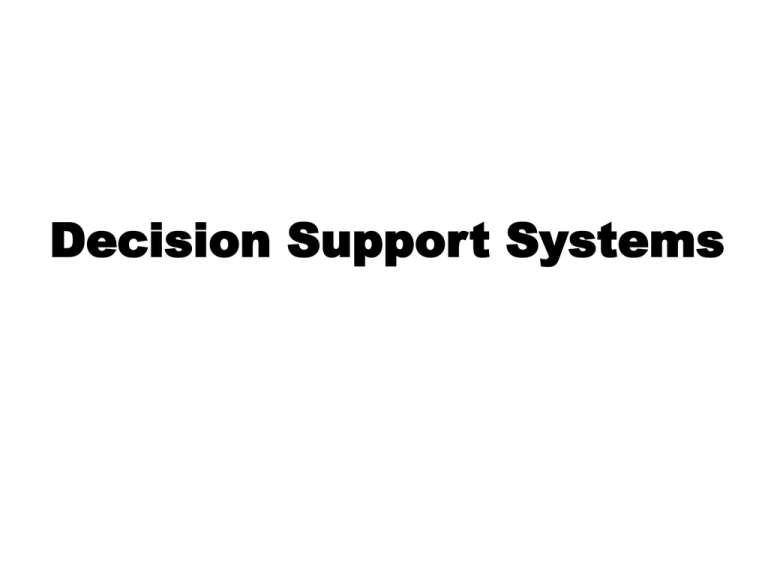
Decision Support Systems Decision Support Systems • The objective of decision support systems is to help you analyze information to find business intelligence • BI is the extraction of the true meaning of information so that you can take creative and powerful steps to gain a competitive advantage. • Because of IT, knowledge workers have been freed from much of the drudgery of manually handling day-to-day transactions. • And now, IT power is augmenting brainpower and thought processes in ways previously seen only in science fiction. In some cases, IT power is actually replacing human brainpower to a limited degree. • Whether to use a decision support system or some form of artificial intelligence depends on the type of decision you have to make and how you plan to go about making it. • Lets look at some of the decisions a knowledge worker is required to make. How do you make a decision? • Four steps: – Intelligence (find what to fix) – Design (find fixes) – Choice (pick a fix) – Implementation (apply the fix) Step 1 • • • • • • • • • • Intelligence (find what to fix): Find or recognize a problem, need, or opportunity (also called the diagnostic phase of decision making). The intelligence phase involves detecting and interpreting signs that indicate a situation which needs your attention. These “signs” come in many forms: consistent customer requests for new-product features, the threat of new competition, declining sales, rising costs, an offer from a company to handle your distribution needs, and so on. Step 2 • Design (find fixes): Consider possible ways of • solving the problem, filling the need, or taking • advantage of the opportunity. In this phase, you • develop all the possible solutions you can. Step 3 • • • • • • • • Choice (pick a fix): Examine and weigh the merits of each solution, estimate the consequences of each, and choose the best one (which may be to do nothing at all). The “best” solution may depend on such factors as cost, ease of implementation, staffing requirements, and timing. This is the prescriptive phase of decision making—it’s the stage at which a course of action is prescribed. Step 4 • Implementation (apply the fix): Carry out the chosen solution, monitor the • results, and make adjustments as necessary. Simply implementing a solution is • seldom enough. Your chosen solution will always need fine-tuning, especially for • complex problems or changing environments. Not Linear • This four-phase process is not necessarily linear: You’ll often find it useful or necessary • to cycle back to an earlier phase. When choosing an alternative in the choice phase, • for example, you might become aware of another possible solution. Then you would go • back to the design phase, include the newly found solution, return to the choice phase, • and compare the new solution to the others you generated. Structured Decision • A structured decision involves processing a certain kind of information in a specified • way so that you will always get the right answer. No “feel” or intuition is necessary. These • are the kinds of decisions that you can program—if you use a certain set of inputs and • process them in a precise way, you’ll arrive at the correct result. Calculating gross pay for • hourly workers is an example. You can easily automate these types of structured decisions • with IT. Unstructured Decision • An unstructured decision is one for which there may be several “right” answers, and • there is no precise way to get a right answer. No rules or criteria exist that guarantee you • a good solution. Deciding whether to introduce a new product line, employ a new marketing • campaign, or change the corporate image are all examples of decisions with unstructured • elements. Most Decisions • In reality, most decisions fall somewhere between structured and unstructured. The job choice decision is an example. • In choosing the right job, the salary part of the decision is structured, whereas the other criteria involve unstructured aspects (for example, your perception of which job has the best advancement opportunity). • Stock market investment analysis is another example of “somewhere in between” because you can calculate financial ratios and use past performance indicators. However, you still have to consider unstructured aspects of the companies, such as projected prime interest rate, unemployment rates, and competition. Recurring Decision • A recurring decision is one that happens repeatedly, and often periodically, whether weekly, monthly, quarterly, or yearly. You’ll usually use the same set of rules each time. When you calculate pay for hourly employees, the calculation is always the same regardless of the employee or time period. Nonrecurring Decision • A nonrecurring, or ad hoc, decision is one that • you make infrequently (perhaps only once), and you may even have different criteria for • determining the best solution each time. What is a DSS? • Narrowly defined, a decision support system (DSS) is a highly flexible and interactive IT system that is designed to support decision making when the problem is not structured. • The term decision support system, used broadly, means any computerized system that helps you make decisions. 3 Components With Examples from Land’s End • Model management: The DSS at Lands’ End has to have models to analyze information. The models create new information that decision makers need to plan product lines and inventory levels. For example, Lands’ End uses a statistical model called regression analysis to determine trends in customer buying patterns and forecasting models to predict sales levels. • Data management: The DSS’s data management component stores Lands’ End’s customer and product information. In addition to this organizational information, the company also needs external information, such as demographic information and industry and style trend information. • User interface management: A user interface enables Lands’ End decision makers to access information and specify the models they want to use to create the information they need.
